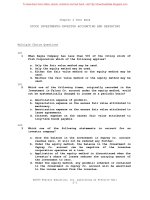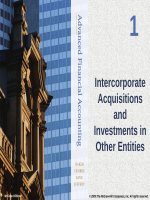Advanced financial accounting by baker chapter 02
Bạn đang xem bản rút gọn của tài liệu. Xem và tải ngay bản đầy đủ của tài liệu tại đây (1.03 MB, 42 trang )
2
Reporting
Intercorporate
Interests
McGraw-Hill/Irwin
© 2009 The McGraw-Hill Companies, Inc. All rights reserved.
Accounting for Investments in Common
Stock
• The method used to account for investments in
common stock depends:
– On the level of influence or control that the investor is
able to exercise over the investee
– On choices made by the investor because of options
available
2-2
Financial Reporting Basis by Level of
Common Stock Ownership
2-3
Accounting for Investments in Common
Stock
• Consolidation involves combining for financial
reporting the individual assets, liabilities,
revenues, and expenses of two or more related
companies as if they were part of a single
company
– Consolidation normally is appropriate when one
company, referred to as the parent, controls another
company, referred to as a subsidiary
– A subsidiary that is not consolidated with the parent is
referred to as an unconsolidated subsidiary and is
shown as an investment on the parent’s balance
sheet
2-4
Accounting for Investments in Common
Stock
• The equity method is used when the investor
exercises significant influence over the operating
and financial policies of the investee and
consolidation is not appropriate
– May not be used in place of consolidation if
consolidation is appropriate
– Its primary use is in reporting nonsubsidiary
investments
• The cost method is used for reporting
investments in equity securities when both
consolidation and equity-method reporting are
inappropriate
2-5
The Cost Method
• Used when the investor lacks the ability either to
control or to exercise significant influence over
the investee
• Accounting Procedures
– The cost method is consistent with the treatment
normally accorded noncurrent assets
2-6
The Cost Method
– At the time of purchase, the investor records its
investment in common stock at the total cost incurred
in making the purchase
– The investment continues to be carried at its original
cost until the time of sale
– Income from the investment is recognized as
dividends are declared by the investee
– Recognition of investment income before a dividend
declaration is inappropriate
2-7
The Cost Method - Illustration
ABC Company acquires 20 percent of XYZ Company’s common stock for
$100,000 at the beginning of the year but does not gain significant influence
over XYZ. During the year, XYZ has net income of $60,000 and pays
dividends of $20,000. ABC Company records the following entries:
2-8
The Cost Method
• Declaration of dividends in excess of earnings
since acquisition
– Liquidating dividends - Dividends declared by the
investee in excess of its earnings since acquisition by
the investor from the investor’s viewpoint
– The investor’s share of these liquidating dividends is
treated as a return of capital, and the investment
account balance is reduced by that amount
– These dividends usually are not liquidating dividends
from the investee’s point of view
• Acquisition at interim date
– Does not create any major problems when the cost
method is used
– Potential difficulty - liquidating dividend determination
2-9
The Cost Method
• Changes in the number of shares held
– Changes resulting from stock dividends, stock splits,
or reverse splits receive no formal recognition in the
accounts of the investor
• Purchases of additional shares
– Recorded at cost similar to initial purchase
– New percentage ownership is calculated to determine
whether switch to the equity method is required
• Sales of Shares
– Accounted for in the same manner as the sale of any
other noncurrent asset
2-10
The Equity Method
• The equity method is intended to reflect the
investor’s changing equity or interest in the
investee
• The investment is recorded at the initial
purchase price and adjusted each period for the
investor’s share of the investee’s profits or
losses and the dividends declared by the
investee
2-11
The Equity Method
• APB Opinion No. 18 (as amended), requires
that the equity method be used for:
1. Corporate joint ventures
2. Companies in which the investor’s voting stock
interest gives the investor the “ability to exercise
significant influence over operating and financial
policies” of that company
• “Significant influence” criterion - 20 percent rule
– In the absence of evidence to the contrary, an
investor holding 20 percent or more of an investee’s
voting stock is presumed to have the ability to
exercise significant influence over the investee
2-12
The Equity Method
• Investor’s equity in the investee
– The investor records its investment at the original cost
– This amount is adjusted periodically:
2-13
The Equity Method - Illustration
ABC Company acquires significant influence over XYZ
Company by purchasing 20 percent of the common
stock of the XYZ Company for $100,000, XYZ earns
income of $60,000 and pays dividends of $20,000.
• Recognition of income
– This entry (equity accrual) is normally is made as an
adjusting entry at the end of the period
– If the investee reports a loss, the investor recognizes its
share of the loss and reduces the carrying amount of the
investment by that amount
2-14
The Equity Method - Illustration
• Recognition of dividends
• Carrying amount of the investment
2-15
The Equity Method
• Acquisition at Interim Date
– No income earned by the investee before the date of
acquisition may be accrued by the investor
– Acquisition between balance sheet dates
• The amount of income earned by the investee
from the date of acquisition to the end of the fiscal
period may need to be estimated by the investor in
recording the equity accrual
2-16
The Equity Method
• Differential
– The difference between the cost of the investment to
the investor and the book value of the investor’s
proportionate share of the investee’s net assets
– The differential on the parent’s books relates only to
the parent’s share of any difference between an total
investee’s fair value and book value
– The differential in the case of an equity-method
investment is implicit in the investment account on the
parent’s books and is not recorded separately
2-17
The Equity Method
• Reasons for the differential
– Investee’s assets worth more than their book values
– Existence of unrecorded goodwill
• Ascertain the portion of the differential pertaining
to each asset of the investee, including goodwill
– The portion of the differential pertaining to limited-life
assets, including identifiable intangibles, must be
amortized over their remaining economic lives
– Any portion of the differential that represents goodwill
is not amortized or written off because of impairment
2-18
The Equity Method
• Amortizing the differential
– Reduce the income recognized by the investor from
the investee and the balance of the investment
account:
2-19
Treatment of the Differential Illustrated
Ajax Corporation acquires 40 percent of the common stock of Barclay
Company on January 1, 20X1, for $200,000. Barclay has net assets on that
date with a book value of $400,000 and fair value of $465,000. Ajax’s share of
the book value of Barclay’s net assets at acquisition is $160,000 ($400,000 x .
40). A $40,000 differential is computed as follows:
The $65,000 excess consists of a $15,000 increase in the value of Barclay’s
land and a $50,000 increase in the value of equipment. Ajax’s 40 percent
share of the increase in the value of Barclay’s assets is as follows:
2-20
Treatment of the Differential Illustrated
$26,000 of the differential is assigned to land and equipment,
with the remaining $14,000 attributed to goodwill as follows:
2-21
Treatment of the Differential Illustrated
The equipment is amortized over its remaining life of five years. Land has an
unlimited economic life. Barclay declares dividends of $20,000 during 20X1
and at year-end reports net income of $80,000 for the year. Using the equity
method, Ajax records the following entries during 20x1:
2-22
The Equity Method
• Disposal of differential-related assets
– Upon disposal, the relevant portion of the differential
must be removed from the investment account on the
investor’s books
– The investor’s share of the investee’s gain or loss on
disposal of the asset must be adjusted to reflect the
fact that the investor paid more for its proportionate
share of that asset than did the investee
• Impairment of Investment Value
– Equity-method investments be written down if their
value is impaired
– Subsequent recoveries may not be recognized
2-23
The Equity Method
• Purchases of additional shares
– If the equity method was being used to account for
shares already held, the acquisition involves adding
the cost of the new shares to the investment account
and applying the equity method from the date of
acquisition forward
– New and old investments in the same stock are
combined for financial reporting purposes
2-24
The Equity Method
• Sale of shares
– Treated the same as the sale of any noncurrent asset
– First, the investment account is adjusted to the date
of sale for the investor’s share of the investee’s
current earnings
– Then, a gain or loss is recognized for the difference
between the proceeds received and the carrying
amount of the shares sold
– If only part of the investment is sold, the investor must
decide whether to continue using the equity method
or to change to the cost method
2-25









